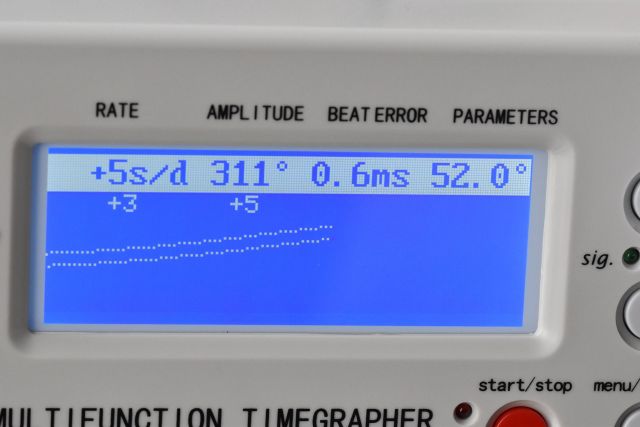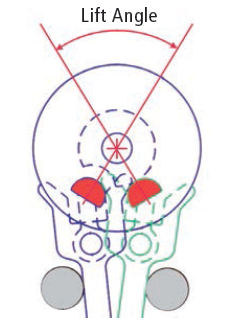So you’ve got the QC images or your brand new best replica but what about your timegrapher results?
Presets
Beat Number
Frequency, the vibration of a movement. The number of balance wheel swings per hour or how many times the watch ticks per hour. This is a preset, depends on the watch you order.
14,400 bph = 4 beats per second
18,000 bph = 5 beats per second
21,600 bph = 6 beats per second
28,800 bph = 8 beats per second
etc
Lift Angle
The angle the balance passes through while interacting with the pallet fork. Important to be set correctly in order to calculate the Amplitude. This preset is per caliber specs.
Most modern watches have a lift angle of 50 – 52 degrees. Generally lift angles range from 44 to 58 degrees. Some other settings are present, for instance Gen co-axials angle is 30 degrees.
Results
Rate
How fast / slow the movement runs (in seconds per day)
great : +/- 5 s/d
acceptable : +/- 12 s/d
If higher / lower?
It is possible to adjust this yourself or ask your dealer to nudge it a bit.
Amplitude
The measure of the amount of rotation in the swing of the balance wheel, in either direction.
Amplitude is higher when a watch is lying flat and usually falls when the watch is in a vertical position, due to increased friction. Amplitude can also fall as the watch winds down and the mainspring delivers less power.
Amplitude is a good indicator of the movements health and if is too high or too low, or that changes too much in different positions, can indicate a problem with the movement.
great : 270-310
acceptable : 250-270
If higher / lower?
Ask for a different watch or have your watch serviced
Beat Error
The amount of time by which the duration of swing differs from one side to the other in the oscillation of a balance wheel. Generally speaking to get a beat error of zero, the roller jewel in the pallet fork must be perfectly centered.
great : 0.0-0.5 ms
acceptable : 0.6-1 ms
If higher?
Ask for a different watch or have your watch serviced.
* Please note that if you are reading your QC from the dealer, you will generally receive only the results of the watch lying flat. All the above recommended measurements are from that position. The measurements in other positions may vary.
Rate is the first number you see on the top left side of the display. This number describes how much time the watch is either gaining or losing per day. The great watches that has been tested and certified has a rate within +/-2s per day in 4-6 different orientations. For these rep movements and low-end Asian movements you can be pleased with +/-10s per day in the “dial up” orientation.
The second number is the amplitude. This number is how far the balance swings from its resting position, i.e the total swing angle of the spring. This number can vary quite greatly without to much impact on the time keeping and the number varies based on how far the mainspring is wound, the best way to test the amplitude is to wind the mainspring fully wait 1 hour and then test it. Most movements stay within 260-300º, with a lot of rep movements hitting higher than that.
A common misconception is that you want a super high amplitude.
While it’s true that a high amplitude is an indication of a healthy watch, to high of an amplitude can cause damage to the escapement parts and wear it out faster or cause an issue known as “knocking” where the impulse pin swings to far and hits the pallet “in the back”. (Graph showing knocking)
The third common number is the beat error. The beat error is the difference in time between the “tic” and the “toc” of the watch. This number in a genuine watch, even lower grade is most often 0.0ms. In a rep movement I believe you can be pleased with everything under 0.7-1.0ms. Bigger differences in the beat error can be a early indication of damage to the balance spring.
The last number is this lift angle. This number is a predetermined number which is based on the angle between when the impulse pin hits the pallet and when the pallet catches the next cog on the escape wheel.
Another number that can be seen often in the QC pictures are 21,600 or 28,800. This number is the number of beats per hour or BPH. This equate to 6 or 8 beats per second, most common in alot of high end reps is 28,800.
The lines on the graph can help you get a visual representation of how the watch movement is behaving. The rate of the watch determines the angle of the lines, lines going “up” means the watch is gaining time and lines going “down” means the watch is losing time.
The beat error determines how far apart the two lines are, if the beat error is 0.00 you should only see one line on the graph.






